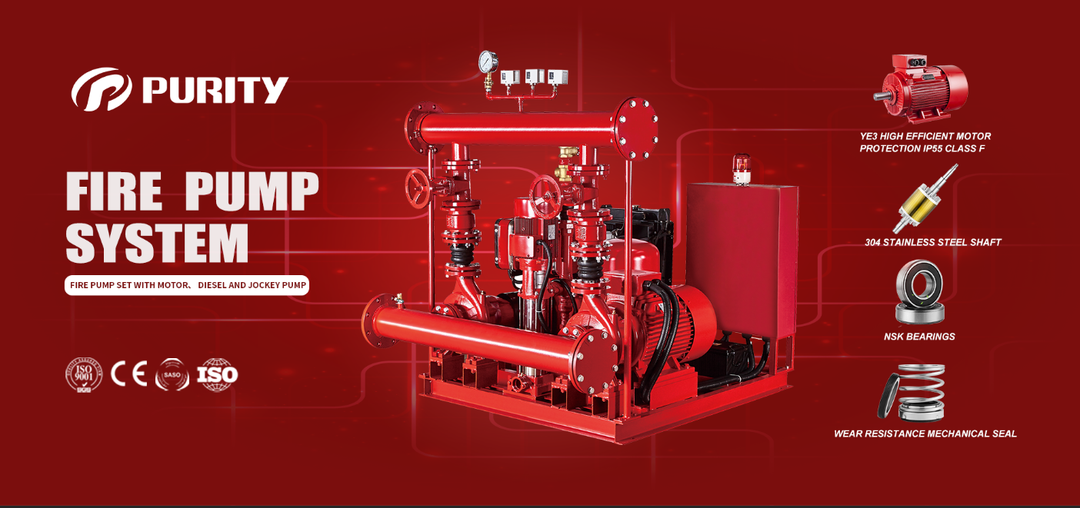In fire protection pumps, both fire pump and jockey pump play pivotal roles, but they serve distinct purposes, particularly in terms of capacity, operation, and control mechanisms. Understanding these differences is crucial for ensuring that fire protection systems function effectively in both emergency and non-emergency situations.
The Role of Fire Pump in Fire Protection Pumps
Fire pumps are at the heart of any fire protection system. Their primary function is to provide a high pressure water supply to fire protection devices, such as sprinklers, fire hydrants, and other firefighting equipment. When the water demand in the system exceeds the available supply, fire pump ensures that sufficient water pressure is maintained.
The Role of Jockey Pump in Maintaining System Pressure
A jockey pump is a small, low-capacity pump that maintains consistent water pressure within the system during non-emergency situations. This prevents the fire pump from activating unnecessarily, ensuring that it is only used during a fire event or system test.
Jockey pump compensates for minor pressure losses that can occur due to leaks, temperature fluctuations, or other factors. By maintaining constant pressure, jockey pump ensures the system is always ready for immediate use without engaging the high pressure fire pump.
Key Differences Between Fire Pump and Jockey Pump
1.Purpose
Fire pump is designed to deliver high-pressure, high-capacity water flow during a fire emergency. They supply water to firefighting equipment to control and extinguish fires.
In contrast, jockey pump is used to maintain steady system pressure during non-emergency conditions, preventing the fire pump from activating unnecessarily.
2.Operation
Fire pump activates automatically when the system detects a drop in pressure due to firefighting activities. It provides a large volume of water in a short period to meet the demands of the fire protection system.
Jockey pump, on the other hand, operate intermittently to maintain pressure levels and compensate for minor leaks or pressure losses.
3.Capacity
Fire pump is high-capacity pumps designed to deliver a substantial amount of water during emergencies. The flow rate is much higher than jockey pumps, which are designed for smaller, continuous flows to maintain system pressure.
4.Pump Size
Fire pump is significantly larger and more powerful than jockey pump, reflecting their role in delivering high volumes of water during emergencies.
Jockey pump is smaller and more compact, as their primary function is to maintain pressure, not to deliver large amounts of water.
5.Control
Fire pump is controlled by the fire protection system and only activate during an emergency or when a system test is conducted. It is not meant for frequent or continuous operation.
Jockey pump is part of a pressure maintenance system and is controlled by pressure switches and controllers. They automatically start and stop based on system pressure levels, ensuring the system remains in optimal condition.
Purity Jockey Pump Advantages
1. Purity jockey pump adopts a vertical segmented stainless steel shell structure, so that the pump inlet and outlet are located on the same horizontal line and have the same diameter, which is convenient for installation.
2. Purity jockey pump combines the advantages of high pressure of multi-stage pumps, small footprint and easy installation of vertical pumps.
3.Purity jockey pump adopts excellent hydraulic model and energy-saving motor, with advantages of high efficiency, energy saving and stable operation.
4. The shaft seal adopts wear-resistant mechanical seal, no leakage and long service life.
Conclusion
Fire pump and jockey pump is integral to fire protection pumps, but their roles are distinct. Fire pumps are the powerhouse of the system, designed to deliver high-capacity water flow during emergencies, while jockey pumps ensure the system’s pressure remains stable during non-emergency times. Together, they form a robust and reliable fire protection solution that guarantees the safety of buildings and occupants in the event of a fire.
Post time: Sep-21-2024





